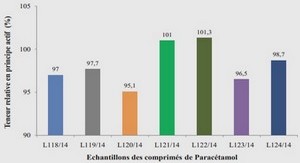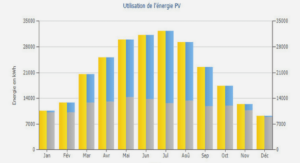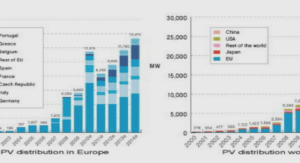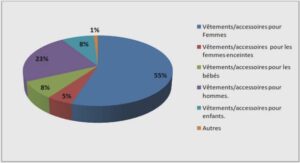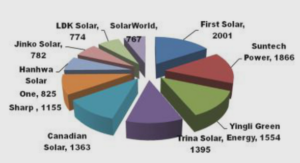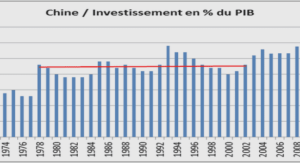APPROCHES NUMERIQUES PAR DES VOLUMES
FINIS DU MODELE DE KELLER-SEGEL
Finite volume method for a Keller-Segel problem
Keller-Segel model
The aim of this chapter is to study the finite volume schemes applied to the elliptic-parabolic model (P) defined as: (P) (P1) ut − ∆u + div (u∇v) = 0, (t, x) ∈ R + × Ω, u = 0, ∂Ω, u (0, x) = u0, x ∈ Ω, (P2) −∆v + τv = 0, x ∈ Ω, v = g, ∂Ω. (4.1) Where Assumption 1 1. Ω is an open bounded polygonal subset of R 2 or R 3 . 2. τ ≥ 0. 3. g ∈ C (∂Ω, R). 4. u0 ∈ C 2 (Ω, R). The chapter is organised as follows: In section 4.3, we give some results related to the existence and the uniqueness of the approximate solution of problem (P2). Under adequate regularity condition on the exact solution of this problem, the finite volume scheme is the first order accurate. In section 4.4, we prove the same results as in section 4.3 (existence and the uniqueness, and C2 error estimate) for problem (P1). The proved is based on the proof of Theorem 3.3 and Theorem 4.1 in [27]. We conclude in section 4.5 the same results obtained in the previous sections for problem (P). Finally, in Section 4.6, we illustrate the method’s performance against test problems from the literature, and verify that the results are in agreement with our numerical analysis.
Theorems and definitions
We introduce some definition and Theorems needed in our work. First we state the existence and uniqueness of the solution. Theorem 4.2.1. [64]. If g ∈ L 3 2 (Ω), u0 ∈ L 2 (Ω). Then, the problem (P) has a unique solution. Remark 4.2.1. The third condition of the assumption assure existence and uniqueness as well as positive of variational solution to problem (P2) via Lax- Milgran’s Theorem and Maximum principle. To obtain a finite volume discretization of problem (P) , we introduce some important notations and definitions: Definition
(Admissible meshes)
Let Ω be an open bounded polygonal subset of R d , d = 2 or 3. An admissible finite volume mesh of Ω, denoted by T, is given by a family of « control volumes », which are open polygonal convex subsets of Ω, a family of subsets of Ω contained in hyperplanes of R d , denoted by Ξ (these are the edges (two-dimensional) or sides (three-dimensional) of the control volumes), with strictly positive (d − 1)-dimensional measure, and a family of points of Ω denoted by P T satisfying the following properties: 1. The closure of the union of all the control volumes is Ω. 2. For any K ∈ T, there exists a subset ΞK of Ξ such that ∂K = K |K = [ σ∈ΞK σ. Furthermore, Ξ = ∪K∈T ΞK. 3. For any (K, L) ∈ T 2 with K 6= L, either the (d − 1)-dimensional Lebesgue measure of K ∩ L is 0 or K ∩ L = σ, for some σ ∈ Ξ, which will then be denoted by K |L . 4. The family P T = (xK)K∈T is such that xK ∈ K (for all K ∈ T ) and, if σ = K |L, it is assumed that xK 6= xL, and that the straight line DK,L going through xK and xL is orthogonal to K |L. 5. For any σ ∈ Ξ such that σ ⊂ ∂Ω, let K be the control volume such that σ ∈ ΞK. If xK ∈/ σ, let DK,σ be the straight line going through xK and orthogonal to σ, then the condition DK,σ ∩ σ 6= ∅ is assumed; let yσ = DK,σ ∩ σ. In this study, we use the following notations 1. size(T) =sup{diam(K), K ∈ T}. 4.2. Theorems and definitions 55 2. For any K ∈ T and σ ∈ Ξ, m(K) is the d-dimensional Lebesgue measure of K and m(σ) is the (d-1)-dimensional measure of σ. 3. Denoting the set of interior (resp. boundary) edges by Ξint (resp. by Ξext). 4. Let N(K) be the set of neighbours of K. If σ = K |L, we denote dσ or dK,L the Euclidean distance between xK and xL and dK,σ is the distance from xK to σ. If σ ∈ ΞK ∩ Ξext, dσ or dK,σ denote the Euclidean distance between xK and yσ. 5. The transmutability through σ is defined by τσ = m(σ) dσ and nK,σ resp (nK) denotes the outward normal unit vector to σ resp (∂K). We note that throughout this chapter we consider T is an admissible mesh in the sense of Definition 3.1 in [27]. Example: FIGURE 4.1: Two control volumes of an admissible mesh see [27]. For the time discretization, we define a temporal partition t n = nk, for n ∈ {0, …, Nk + 1} where k ∈ is the time step and Nk = max{n ∈ N , nk <¸T}. The value (u n K, vK), is an approximation of (u(nk, xK), v(xK)) at (xK, tn ) ∈ K × (0 ). Definition 4.2.2. Let Ω be an open bounded polygonal subset of R d , d = 2 or 3, and T is an admissible mesh. Define X(T) as the set of functions from Ω to R which are constant over each control volume of the mesh. Definition 4.2.3. (Discrete H1 0 norm) Let Ω be an open bounded polygonal subset of R d , d = 2 or 3, and T an admissible finite volume mesh. For v ∈ X(T), define the discrete H1 0 norm by kvk1,T = X σ∈Ξ τσ (Dσv) 2 !1 2 , (4.2) 56 Chapter 4. Finite volume method for a Keller-Segel problem where Dσv = |vL − vK| , ∀σ ∈ Ξint, σ = K |L, |vK| , if σ ∈ ΞK ∩ Ξext. (4.3) 4.3 Finite volume method for the elliptic problem (P2) A finite volume scheme for the problem (P2) is given by X σ∈ΞK FK,σ + τm (K) vK = 0, ∀K ∈ T, (4.4) FK,σ = −τK|L (vL − vK), ∀ σ ∈ Ξint, if σ = K|L, (4.5) FK,σ = −τσ (g (yσ) − vK), ∀ σ ∈ Ξext, where vσ = g (yσ), ∀ σ ∈ Ξext. (4.6) We recall some important results of the approximate solution of elliptic problem (P2) (for proof we can see [27]). Proposition 4.3.1. [27]. Under Assumption 1. Let T be an admissible mesh. If g (yσ) ≥ 0for all σ ∈ Ξext, then the solution (vK)K∈T of (4.4)-(4.6) is positive for any K ∈ T. Lemma 4.3.1. (Existence and uniqueness) [27]. Under Assumptions 1, let T be an admissible mesh ; there exists a unique solution (vK)K∈T to the equations (4.4)- (4.6). Theorem 4.3.1. (C 2 error estimate) [27]. Under Assumption 1, let T be an admissible mesh, (vK)K∈T is the solution to (4.4)-(4.6). Assume that the unique variational solution v of problem (P2) satisfied v ∈ C 2 (Ω). Let eT ∈ X(T) defined by eT = eK = (v(xK) − vK) for a.e. x ∈ K and for all K ∈ T. Then, there exists C > 0 depends only on v, τ and Ω such that keT k1,T ≤ Csize(T), (4.7) keT kL2(Ω) ≤ Csize(T), (4.8) and X σ ∈ Ξint σ = K|L m (σ) dσ (vL − vK) dσ − 1 m (σ) Z σ ∇v(x).nK,σdδ(x) 2 + X σ ∈ Ξext σ = K ∩ ∂Ω m (σ) dσ (g (yσ) − vK) dσ − 1 m (σ) Z σ ∇v(x).nK,σdδ(x) 2 ≤ C (size(T))2 . 4.4. Finite volume method for the parabolic problem (P1) 57 4.4 Finite volume method for the parabolic problem (P1) Applying the following implicit finite volume scheme for the discretization of parabolic problem (P1) yield: m (K) u n+1 K − u n K k + X σ∈ΞK F n+1 K,σ + X σ∈ΞK VK,σu n+1 σ,+ = 0, (4.9) for all K ∈ T, and for all n ∈ {0, . . . , Nk}, u 0 K = u0 (xK) ∀K ∈ T, (4.10) where F n K,σ = −τK|L (u n L − u n K), for all σ ∈ Ξint such thatσ = K |L, (4.11) for n ∈ {1, …, Nk + 1} , F n K,σ = τσ (u n K) ∀σ ∈ Ξext ∩ ∂Ω, for n ∈ {0, …, Nk + 1} , (4.12) u n σ,+ = u n K, if VK,σ ≥ 0, u n L , if VK,σ < 0, for all σ ∈ Ξint such that σ = K |L , (4.13) u n σ,+ = u n K, if VK,σ ≥ 0, 0, if VK,σ < 0, for all σ ∈ ΞK such that σ ⊂ ∂Ω, (4.14) VK,σ = τσ (vL − vK), for all σ ∈ Ξint such that σ = K |L , (4.15) and VK,σ = τσ (g (yσ) − vK), for all σ ∈ Ξext such that σ ⊂ ∂Ω, (4.16) with vK satisfies the equations (4.4)-(4.6) for all K ∈ T. 4.4.1 Error estimate In the following Theorem we give a L ∞ estimate as well as the estimate error. Theorem 4.4.1. Let Ω be an open bounded polygonal subset of R d , ¸T > 0. Let u ∈C 2 (R+ × Ω, R) be defined in (P1) and v ∈ C 2 (Ω, R) defined in (P2). Let u0 ∈ C 2 (Ω, R) and g ∈ C 0 (∂Ω, R+). Let T be an admissible mesh and k ∈ (0, ¸T). Then there exists a unique vector (uK)K∈T satisfying (4.9-4.15). In addition to that, there exists C which depends only on u0 such that sup {|u n K| , K ∈ T, n ∈ {1, …, Nk + 1}} ≤ C. (4.17) 58 Chapter 4. Finite volume method for a Keller-Segel problem Furthermore, let e n K, = u (t n , xK) − u n K, for K ∈ T , n ∈ {1, …, Nk + 1} and h = size(T). Then, there exists C > 0 depends only on u, v, Ω and ¸T such that X K∈T m (K) (e n K) 2 !1 2 ≤ C (h + k), ∀K ∈ T, ∀n ∈ {1, …, Nk + 1} . (4.18) Proof. i) Existence and uniqueness and L∞estimate For the existence and uniqueness of finite volume scheme of the solution, we can follow the proof of Lemma 3.2 page 42 in [27]. Let us now prove the estimate (4.17). Let XK ∈ K, n ∈ {0, …, Nk} for all K ∈ T. Then, we claim that min u n+1 K , K ∈ T ≥ min {min {u n K, K ∈ T} , 0} . (4.19) Indeed, if min u n+1 K , K ∈ T < 0, let K0 ∈ T such that u n+1 K0 = min u n+1 K , K ∈ T . Since u n+1 K0 < 0 and replacing in the relation (4.9) K by K0 get to m (K) u n+1 K0 − u n K0 k = − X σ∈ΞK0 F n+1 K0,σ− X σ∈ΞK0 VK0,σ u n+1 σ,+ − u n+1 K0 − X σ∈ΞK0 VK0,σ u n+1 K0 (4.20) with K0 ∈ T and ∀n ∈ {0, …, Nk} . From the definition of F n+1 K0,σ and u n+1 σ,+ , we deduce that X σ∈ΞK0 F n+1 K0,σ ≤ 0 and X σ∈ΞK0 VK0,σ u n+1 σ,+ − u n+1 K0 ≤ 0. Next, in view the Proposition 4.3.1, the function v is positive verifying ∆v + τv = 0 , then we find X σ∈ΞK0 VK0,σ u n+1 K0 = u n+1 K0 Z ∂K0 ∇v.nK0 (x)γ(x) = τ un+1 K0 Z K0 v dx ≤ 0. (4.21) u n+1 K0 ≥ u n K0 , this proves (4.19) and by induction, we deduce that min u n+1 K , K ∈ T ≥ min min u 0 K, K ∈ T , 0 . (4.22) This implies that max u n+1 K , K ∈ T ≤ max max u 0 K, K ∈ T , 0 . So, inequality (4.17) is satisfied with C depend only of uo. 4.4. Finite volume method for the parabolic problem (P1) 59 ii) Error estimate One uses the regularity of the data and the solution to write an equation for the error e n K, = u (t n , xK) − u n K, defined for K ∈ T and n ∈ {1, …, Nk + 1}. Note that e 0 K = 0 for K ∈ T. Let n ∈ {1, …, Nk}. Integrating the first equation of problem (P1) over each control volume K of T, at time t = t n+1 : Z K ut .
1 Introduction |
